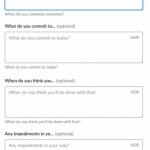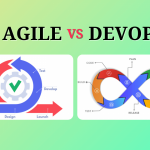
Agile Methodology – The Complete Guide
Content
What is Agile Methodology?
Agile methodology is an iterative and incremental approach to software development. In Agile, we have small incremental builds presented in multiple iterations to the end-user and other stakeholders for their feedback. Based on the feedback, changes are incorporated in the next iterations of the build on the basis of their priority.
In agile, the different cross-functional teams work together in the different iterations of the build with an emphasis on more face-to-face interaction and less formal documentation.
12 Key Principles of Agile Manifesto
- Customer Satisfaction – The first principle which is the highest priority of any project is customer satisfaction by achieving quick and continuous delivery of the software.
- Accommodate Changing Requirements – Agile process easily accommodates requirements change in the development process; the changes can be introduced throughout the development period and even with the changes the software will be developed without unnecessary delays.
- Frequent Delivery – The agile process encourages frequent iterations of working software in a short time (2 weeks to 2 months).
- Continuous Communication – In agile, the developers and the business stakeholders are in constant communication via various meetings.
- Motivate Team Members – Agile makes emphasis on motivation and encouragement of the individual resources; which ultimately helps in delivering high-quality work.
- Face-to-face Communication – For efficient communication, the development teams should be co-located so that they can have face-to-face interactions.
- Working Software – Measure of progress for any agile project is to deliver working software to the customer.
- Sustainable Development – Agile promotes sustainable development. In each iteration, various teams involved in an agile process should maintain a constant speed at which they can deliver working software.
- Improve Design – Developers and project managers should continuously focus on improving design; technical quality.
- Simplicity – Agile process emphasis on keeping things simple; teams should focus only on the necessary tasks and features; and remove any complex features.
- Self-organizing Teams – Agile teams need to be self-organizing and cross-functional; such teams will help to deliver good quality software by taking ownership, having good and continuous communication, making right and quick decisions, etc.
- Regular Assessment – Teams should assess their working style and their past work continuously at periodic intervals to learn from their mistakes and improve their performance in the next iterations.
Agile Methodologies
Basically, agile is a methodology and there are different implementations following this methodology. Following are some of the most widely used agile implementations-
- Scrum – Scrum is one of the most popular implementations of agile where different roles like – product owner, scrum master and team members are assigned to different participants of software development. Daily scrum meeting is organized for the updates and a build is delivered in a two to three-week cycle called a sprint.
- Extreme Programming (XP) – Extreme programming is an agile implementation in which frequent customer feedback and changes are incorporated with a focus on quality software. The quality of the software is maintained by following the coding practices like pair programming(code reviews, unit testing, etc.) to the extreme level. Hence, the name extreme programming.
- Kanban – Kanban is a development approach in which the tasks are organized in a Kanban board, wherein we can track the progress of the work, helping in decision making.
- Crystal Clear – Crystal clear development like other agile methodologies focuses on frequent delivery and feedback. It is a lightweight approach based on the fact that customization of processes and practices is required to meet the project-specific requirements.
- Lean Software Development – Lean software development methodology is based on seven lean principles – eliminate waste(like any code not adding value), amplify learning, decide late, deliver fast, empower team, build integrity and See the Whole(see the product as a whole).
Features of Agile
Following are some of the features of Agile methodology-
- Agile allows frequent deliverables to the end-user.
- Customer feedback and changes are embraced and incorporated in the iterations based on their priority.
- Its emphasis on the collaborative work of the cross-functional teams.
- It focuses on more interaction and face-to-face communications.
- It promotes regular review of the whole development process and fine-tuning if required.
Advantages of Agile Methodology
Following are the advantages of Agile methodology-
- Agile is very much suited for projects where requirements and the end product is not very clear.
- It promotes customer satisfaction as their feedbacks and changes are embraced.
- It reduces risk factors as early deliverables are made visible to the end-users.
- Exhaustive planning is not required at the beginning of the development process.
- It is easy to manage with minimal rules and more flexibility.
- Dividing the project into incremental deliverable builds leads to more focus on the quality of the product.
Disadvantages of Agile Methodology
Following are the disadvantages of Agile methodology-
- As it is highly customer-centric, so it can pose a problem when the customer does not have a clear understanding of the product and process.
- Lack of formal documentation and designing leads to a very high dependency on individuals for training and other tasks.
- For complex projects, the resource requirement and effort are difficult to estimate.
- Frequent deliverables, feedback, and collaboration can be very demanding for some customers.
- Because of the ever-evolving features, there is always a risk of the ever-lasting project.
Difference between Agile and Waterfall
| Waterfall Methodology | Agile Methodology |
|---|---|
| Waterfall involves a large team size where coordination among teams decreases. | Agile intends a smaller team size for higher coordination. |
| The customer intervenes only after completing the development process. | Continuous feedback is taken from the customer to deliver robust and high-quality products. |
| Its methodology is quite sequential. | Agile methodology is incremental and iterative. |
| None of the testing or development levels overlap each other. | The testing and development levels often overlap each other |
| Acceptance tests are carried out only once, at the last stage. | Acceptance tests are taken continuously after every iteration. |
| Changes in deliverables are costly. | Changes are obvious so it doesn’t impact that much on the deliverable. |
| Testing is performed towards the end of the project. You don’t know whether the deliverable works when you are about to finish it. Any failure in any of the functionality takes you back to the beginning of the product from where it started to find the root cause of it. | Testing is done parallelly in pieces so that if any functionality fails it can be analyzed quickly and easily rectified. |
This concludes our post on Agile Methodology, its principles, features, advantages, and disadvantages. If you have any queries or suggestions, do let us know in the comments.




